Stevie Ray Vaughan: Couldn't Stand The Weather Legacy Edition album review
SRV And Double Trouble's 1984 reissue track-by-track
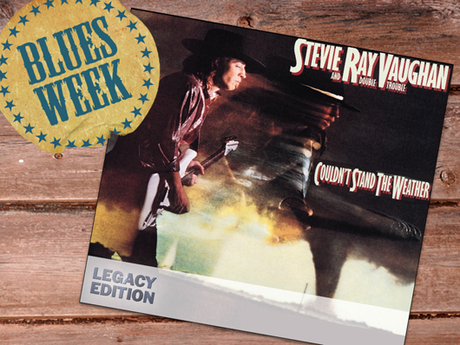
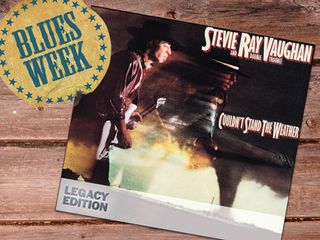
Stevie Ray Vaughan And Double Trouble's second album, Couldn't Stand The Weather, recorded in 19 days and released in 1984, found the band riding the wave of Stevie's Bowie association and the success of their smouldering debut of the previous year - the trio were at the top of their game, and brimming with confidence.
Hooked up with legendary producer John Hammond, they were booked into day-only sessions in New York's legendary Power Station studios, meaning they had to set up and take down their gear on a daily basis. The well-documented, self-destructive drink-and-drugs-fuelled mayhem was well underway too, but at this point, they could handle it. They were a Texas hurricane hitting the Big Apple.
On the eve of the 20th Anniversary of Stevie Ray's tragic death, the album's been re-released as a Legacy Edition. It adds three previously unreleased bonus tracks from the 1984 Couldn't Stand The Weather sessions, four tracks previously released on 1999's Expanded Edition, and a live gig recorded in Montreal in August 1984.
Remastering-wise, there may not be much in the way of drastic sonic alteration here to get our teeth into. Instead, we'll revisit this still-underrated record with an eye to which licks you can steal (NOTE: the timings mentioned are taken from the album tracks, not the embedded live versions), and to appreciate the powerhouse that was Stevie Ray Vaughan And Double Trouble at the height of their pomp once again.
So batter that Strat, tune down to Eb, dust off your cowboy hats and Indian headdresses and let's go...
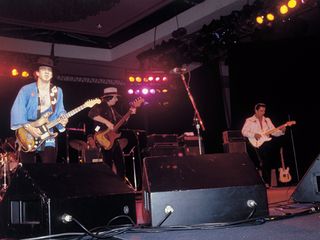
L-R: SRV, Tommy Shannon and Jimmie Vaughan © Jean Krettler
1. Scuttle Buttin'
One of two self-penned instrumentals on the record, Scuttle Buttin' is a stinging statement of intent that became SRV's de facto set opener. In the same way as Texas Flood's showpiece, Rude Mood, took Lightning Hopkins' Lightning Skyhop as its original inspiration, Stevie Ray confessed that Scuttle Buttin' was: "Just another way of playing Lonnie Mack's Chicken Feed."
Get the MusicRadar Newsletter
Want all the hottest music and gear news, reviews, deals, features and more, direct to your inbox? Sign up here.
Every true blues fan remembers where they were when they first heard it - its mixture of speedy runs, daredevil fingerslides and chunky doublestops, not to mention its brimming energy, was only ever again rivalled by Say What! on 1985's otherwise lethargic follow-up album, Soul To Soul.
Learn this lick: Apart from the deft, right-hand-testing main lick (those are finger slides, not bends), any blueser needs the arresting rhythmic, pick-and-fingers doublestop lick at 1:01 in their vocabulary.
Listen: SRV - Scuttle Buttin' (live at Montreux Jazz Festival, 1985)
2. Couldn't Stand The Weather
One of his most inventive compositions, it's a huge frustration that Stevie never explored this rich vein of songwriting further. Channelling the funkier aspects of Hendrix's chordal approach and chaining it to a roaring Stax-like rhythmic drive, the Doppler effect of brother Jimmie's Leslie-cabbed guitar holds the rhythm down cold.
And the solo section is a breathtaking display of how to harness FX, fierce vibrato and a Strat's tone control to subtly intensify a guitar solo.
Learn this lick: One of the slickest pentatonic runs anyone ever pulled out of a guitar neck, listen to 4:17 for a demonstration of just how much Stevie owns the funk...
Listen: SRV - Couldn't Stand The Weather (live at Newport Jazz Festival, 1985)
3. The Things (That) I Used To Do
Also featuring the thick, chorused keyboard-style rhythm voicings of big brother Jimmie, this Guitar Slim cover even outshines Texas Flood in the relentlessness stakes. Utterly torrential from start to finish, Stevie strings together colossal doublestop runs and bends those .13 -.58 strings to finger-bleeding breaking point here.
Proving his versatility within the narrow slow-blues format, he rarely touched on this molten, less glassy, mid-saturated tone in subsequent recordings. More's the pity...
Learn this lick: The insistent, cloying hammer-on onto the A note over the V chord at 3:41 is an economical yet surprisingly effective device for any blues toolkit.
Listen: SRV - The Things (That) I Used To Do (live in Honolulu, 1984)
Next: tracks 4-7
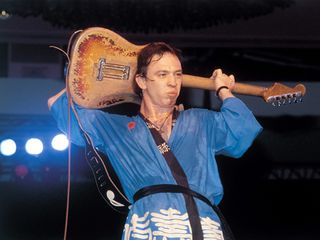
© Jean Krettler
4. Voodoo Child (Slight Return)
Anyone covering a song that should be universally regarded as the greatest-ever use of an electric guitar showed Stevie's jutting-jawed determination to recast Hendrix's spirit for a new generation of fans, regardless of the flak he knew he would take from the blues purists.
Producer John Hammond loved this cover so much he wanted to call the record 'Voodoo Chile'. SRV's more visceral string-wrenching, his feedback explorations, and more urgent on-the-beat rhythmic approach take it way beyond the pastiche that such a title would've implied.
Learn this lick: Stevie's interpretation of Hendrix's one-hand-on-the-'board, one-in-the-air, single-string descent showpiece is beautifully executed at 2:34.
Listen: SRV - Voodoo Child (Slight Return) (live at El Mocambo, 1983)
5. Cold Shot
A song that secured heavy rotation on the then-fledgling MTV station, on account of its hefty riff (courtesy of a Lesley-style Fender Vibroverb) and a loveably goofy video, this Double Trouble standard was written by SRV's former bandmates Mike Kindred and WC Clark.
Recorded at 4am, that's what explains the still-yawning, laid-back feel of the sidling drum groove.
Learn this lick: Stevie's use of the pick-and-fingers technique is exemplified by the solo-opening phrases at 1:38 - the clamouring high A (alright, Ab) on the first string helps fill up the lead sound and is a very effective way of adding a jazzy inflection.
Listen: SRV - Cold Shot (live at Midtfyns Festival 1988)
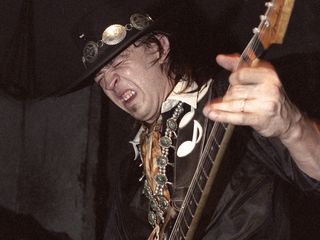
Guitar face? Live in Berkeley, California, 1983 © Clayton Call / Retna Ltd./Retna Ltd./Corbis
6. Tin Pan Alley (aka Roughest Place In Town)
The first song the band recorded for their session, astonishingly, this version of the smouldering slow minor blues is actually a live 'soundcheck' take - that shows off the band's telepathic qualities to a 'T'. SRV's extended phrasing sits exactly equidistant between the singing, full-on amp distortion of live workouts such as Texas Flood, and the pin-drop, see-your-own-breath dynamic range of Lenny and Riviera Paradise.
We have his custom Charlie Wirz, on its neck-position Danelectro lipstick pickup, and his pair of Vibro Verbs to thank for this heavenly tone.
Learn this lick: The IV chord-targeting, Otis Rush-like 'pick scrape' lick at 2:16 skilfully heightens the drama, and clearly made an impression on self-confessed SRV devotee John Mayer.
Listen: SRV - Tin Pan Alley (aka Roughest Place In Town)
7. Honey Bee
Here's the sound of 'Yellow', the thoroughly abused 1964 Stratocaster that came to SRV via Charlie Wirz and its previous owner, Vince Martell of Vanilla Fudge. That hollow, bell-like tone on this straightforward shuffle is due to the routing in the guitar, which was gouged to accommodate four (!) humbuckers before being changed back to a lone stock Fender treble single-coil in the neck position.
Note, too, how the song subtly messes with the I-IV-V progression to keep things fresh... And how Stevie never forgets to target the underlying chords with his triplet-littered leads.
Learn this lick: You can almost see the lightbulb go on as Stevie reverses the repeated 'Ernie' lick at 1:00 to create an arresting change of pace.
Listen: SRV - Honey Bee (live at The Spectrum, Montreal, 1984)
Next: tracks 8-11
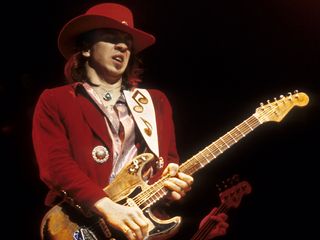
Live in San Francisco, 1984 © Clayton Call / Retna Ltd./Retna Ltd./Corbis
8. Stang's Swang
This Vaughan-penned eulogy to the jazz influences in his playing - namely Kenny Burrell, Grant Green and Wes Montgomery - is also a chance for the determined guitar slinger to dust off those muffly octaves and inversions and prove he was no musical one-trick pony.
Recorded with Vaughan's Gibson Johnny Smith jazz guitar, it also features Thunderbirds drummer Fran Christina and saxophonist Stan Harrison.
Learn this lick: The main riff (0:27) is such a full-on finger twister it could almost be a practice exercise...
Listen: SRV - Stang's Swang (live at Lupo's Heartbreak Hotel, 1979)
9. Empty Arms
Onto the bonus tracks: this first saw the light of day on 1991's The Sky Is Crying. Though still from the same 1984 Couldn't Stand The Weather sessions, why it didn't make the cut for that album is a mystery, although Stevie did reportedly have a disagreement with engineer Richard Mullen over the speed of the song.
It's a pity, since its lead playing, hovering restlessly between major and minor pentatonic and reminiscent of the likes of Freddie and BB King, shows off yet another facet of his playing and is territory Vaughan very rarely explored.
Learn this lick: Those elegant moveable Stormy Monday-esque sixth triads that make up the main hook (0:08) can be lifted and used in practically any blues, at any tempo.
Listen: SRV - Empty Arms
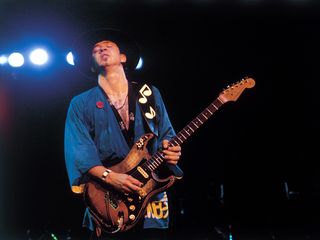
© Jean Krettler
10. Come On (Pt. III)
Another outtake which will be familiar to fans from the Sky Is Crying compilation, this third-hand reworking of the Earl King standard Come On is a well-observed version, but not a patch on SRV's other Hendrix covers.
The band had only booked daytime sessions, so had to pack down and then reset their gear - perhaps this was done when he'd got his Voodoo Child sound together. A more streamlined version shows up on Soul To Soul.
Learn this lick: Wahs at the ready for the classic Hendrix-ism at 1:53. Hammer-on and pull off on the 15th fret while tremolo-picking the first string and stomping that wah for all you're worth!
Listen: SRV - Come On (Pt. III) (live in Philadelphia, 1987)
11. Look At Little Sister
Another erstwhile, already-in-the-bank track that made it onto Soul To Soul, this Hank Ballard & The Midnighters run-through has also already been heard on the Expanded Edition of the album.
That greasy, down 'n' dirty shuffle is the perfect demonstration of why Stevie Ray favoured Eb tuning - which he felt added extra tonal colour, as well as allowing him to use heavier-gauge strings and aiding his singing.
Learn this lick: It's business as usual until 1:37, when SRV's manic bending takes us briefly to another place entirely.
Listen: SRV - Look At Little Sister (live at Montreux Jazz Festival, 1985)
Next: tracks 12-15
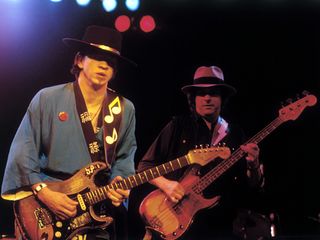
L-R: SRV and Tommy Shannon © Jean Krettler
12. The Sky Is Crying
One of three previously unreleased 1984 outtakes on the Legacy Edition, SRV opens this version of the Elmore James classic with a spoken count-in. And his guitar has a much 'fuller' sound too, likely down to his use of a Tube Screamer to add cranked amp sustain to those wailing bends - this is Stevie Ray delving deep into the blue streak in his soul.
Learn this lick: When SRV is in full-on Albert King mode, as here, you have to get those finger-shredding, one-finger-per-fret, second-position bends at 1:00 under your fingers - it's The Law.
Listen: SRV - The Sky Is Crying
13. Hide Away
Compare Freddie King, Eric Clapton, Jeff Healey and Stevie Ray's versions of this song back to back, and you can't help but pick on the essential differences in style in everything but the actual note choices: the fretboard positions they choose, the subtle phrasing variations, the tones they dial in, the rhythmic emphasis, everything about the different versions is idiosyncratic.
Stevie stamps his personality all over the melody, and the band plays with the assurance of an outfit who've been doing it live since they were kids.
Learn this lick: If you don't already know it, it's time to pick up your guitar and master this famous Freddie King doublestop run-down at 1:29.
Listen: SRV - Hide Away (live at Montreux Jazz Festival, 1982)
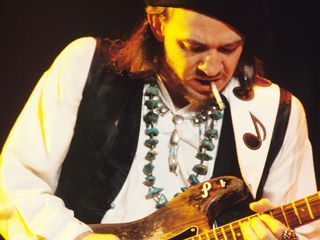
Live in Texas, 1986 © Joe Giron/Corbis/Corbis
14. Give Me Back My Wig
Another previously unreleased outtake, this jaunty shuffle may jar with the prevailing mood of serious guitar heroics but has a charm all of its own. Despite the throwaway levity of its lyrics, this was one of the songs the band played in their poorly received 1982 Montreux Festival appearance.
Still, it was a jazz festival, so let's be honest - who cares what they think? Jazz aficionados wouldn't know decent party music if it sat on their face and wiggled, which is exactly what this vapid, dumb-ass crowd-pleaser does, and does well.
Learn this lick: The licks starting at 0:27 are a great way to mix open-E slide and low bass accompaniment.
Listen: SRV - Give Me Back My Wig
15. Boot Hill (previously unreleased 1984 version)
Fans will be familiar with The Sky Is Crying's more 'roadhouse' version, showcasing SRV's lesser-spotted slide skills on his Gibson Charlie Christian model. This cover of a Sly Williams tune was recorded by SRV for practically every album session, but never quite fitted into the overall running order.
This version is full of crunching major triads designed to mimic the slide, and speedy out-of-nowhere slides all the way up the high E string to add to the fun.
Learn this lick: And this time, SRV imitates a slide player with the ancient sounding blues staples at 1:00.
Listen: SRV - Boot Hill (live in Washington, 1983)
Next: tracks 16-19
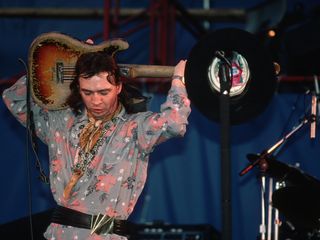
SRV striking a familiar pose in New York, 1983 © Lynn Goldsmith/Corbis
16. Wham!
This devastating cover of a 1963 Lonnie Mack instrumental, previously available on The Sky Is Crying, was a hugely significant record for the fledgling SRV. It was the first single he ever owned (though Jimmie remembers it being his) and he played it to destruction over and over - we all have a record like that in our past and as far as his guitar technique was concerned, this was Stevie's Primal Scene.
Lonnie Mack's partial-chord rhythm and metronomic, fleet-fingered lead are indelibly stamped on SRV's style.
Learn this lick: Few guitar players have ever travelled from IV and back to I in such an elegant manner as SRV does at 0:49. Learn it - you'll impress your friends, repel your enemies and attract every single girl in the room.
Listen: SRV - Wham!
17. Close To You
Willie Dixon, the master blues composer, wrote this and played bass on the Muddy Waters version. It was covered, somewhat quixotically, by The Doors, with Ray Manzarek belting out a surprisingly accomplished vocal. When it's Double Trouble's turn, the magic evaporates somewhat - the listless ring to SRV's voice deflates the song's energy, although the band is tight and the almost entirely doublestopped solo is a lesson in blues economy.
Learn this lick: The turnaround at 0:40 is akin to the trademark phrase SRV would use to finish off a solo, just in reverse - and is well worth adding to your repertoire.
Listen: SRV - Close To You
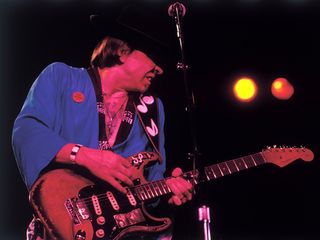
© Jean Krettler
18. Little Wing
This incandescent, soulful, Grammy-winning instrumental was also captured during the Power Station sessions. Over to Jimmie Vaughan for the definitive summary:
"More than anything I can think of, this one shows all of Stevie's different influences on one song. You've got jazz, you've got blues, you've got Hendrix. But at the same time, it sounds like him. It's all mixed up. It gets real tender, and then it gets real tough. It's hard for me to listen to it, because you feel like he's right in the room with you. It sucks you in. If you listen closely, especially with headphones, you can even hear his amp buzzing."
Learn this lick: The chordal pedal-steel-type bends that SRV hammers at 3:23 are difficult to strum with this intensity, but it's worth a try nonetheless.
Listen: SRV - Little Wing
19. Stang's Swang (Previously unreleased alternate take)
That there's no saxophone doubling the main riff in this alternate and previously unreleased trio-only take is immediately obvious. But the much more solidbodied and gruffer tone is the result of SRV using Charlie - a bitsa Strat-style guitar put together by Stevie's friend, guitar-shop owner Charlie Wirz, for the recording in preference to the hollowbody Gibson used on the album version.
Learn this lick: The tremolo-picked pedal-note riff at 1:22 manages to be bluesey, rocky and jazzy all at the same time, and is a tough workout for your right-hand technique.
Listen: SRV - Stang's Swang (live at Lupo's Heartbreak Hotel, 1979)
Next: Disc two (live at Montreal)
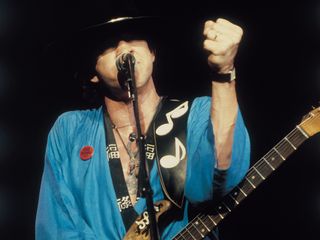
© Jean Krettler
Disc two: Live at Montreal: recorded at The Spectrum on August 17th, 1984
A great cross-section of tried-and-trusted and untested material, this live recording represents the latter of two sets played that day by the band. Double Trouble played 150 gigs in 1984, and they were at that transitional point where they were playing both small clubs booked before their reputation preceded them, and the larger arenas their fame commanded them.
A great snapshot of a still hungry, telepathically tight band at the height of their powers.
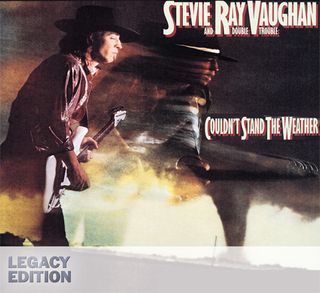
Disc two tracklist:
1. Testify
2. Voodoo Child (Slight Return)
3. The Things (That) I Used To Do
4. Honey Bee
5. Couldn't Stand The Weather
6. Cold Shot
7. Tin Pan Alley (aka Roughest Place In Town)
8. Love Struck Baby
9. Texas Flood
10. Band Intros
11. Stang's Swang
12. Lenny
13. Pride And Joy
Liked this? Now read: The 25 best blues guitarists of all time
Connect with MusicRadar: via Twitter, Facebook and YouTube
Get MusicRadar straight to your inbox: Sign up for the free weekly newsletter
Most Popular







